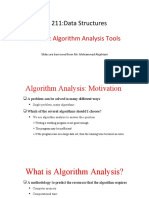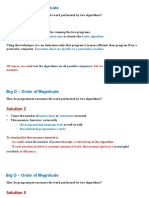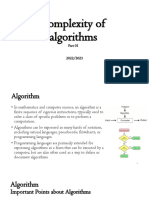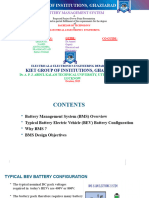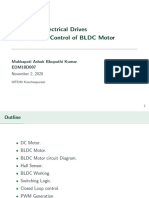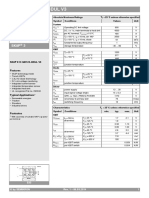Material adapted from: ECE250, Waterloo
CS2001 – DATA STRUCTURES
Lecture # 02
August 28, 2023 Dr. Rabia Maqsood
Fall 2023 rabia.maqsood@nu.edu.pk
FAST – NUCES, CFD Campus
TODAY’S TOPICS
q Time Complexity
q Big-O notation
CS 2001 - FALL 2023 2
WHY ANALYSIS OF ALGORITHMS?
Analyzing an algorithm means to predict the resources that the algorithm
requires.
It includes memory, communication bandwidth, computer hardware and
some others.
But more important is the computational time.
CS 2001 - FALL 2023 3
WHY ANALYSIS OF ALGORITHMS?
Suppose we have two algorithms; how can we tell which is better?
Option 1: we could implement both algorithms, run them both & compute
execution time
How?
Any issue with this approach?
Expensive and error prone, machine & compiler dependent
Option 2: preferably, we should analyze them mathematically
Perform algorithm analysis using asymptotic complexity
Calculate the no. of (primitive) operations to be performed
CS 2001 - FALL 2023 4
AYSMPTOTIC COMPLEXITY
Evaluate the performance of an algorithm in terms of input size
Focus is not to calculate the actual execution time, but how the time (or space) taken by an algorithm
increases with the input size
Example: write N elements in an array to a file
Algorithm: write an array to a file
Open the file
While more elements in array do
write the next element
(N * time-to-write-one-element) + time-to-open-the-file
CS 2001 - FALL 2023 5
BIG-O NOTATION
Big-O or order of magnitude: expresses computing time (complexity) as the term in a
function that increases more rapidly relative to the size of a problem
For example: f(N) = N4 + 2000N2 + 50N + 100
f(N) is order of N4 or in Big-O notation, O(N4)
Lower terms become insignificant as the N or size of the input increases!
CS 2001 - FALL 2023 6
AYSMPTOTIC COMPLEXITY
Evaluate the performance of an algorithm in terms of input size
Focus is not to calculate the actual execution time, but how the time (or space) taken by an algorithm
increases with the input size
Example: write N elements in an array to a file
Algorithm: write an array to a file
Open the file Now, what is the time
While more elements in array do complexity in Big-O notation?
write the next element
(N * time-to-write-one-element) + time-to-open-the-file
CS 2001 - FALL 2023 7
COMMON ORDERS OF MAGNITUDE
Notation Meaning
O(1) Constant time
O(log2N) Logarithmic time
O(N) Linear time
O(N log2N) -
O(N2) Quadratic time
(O2N) Expoential time
By Cmglee (Own work) [CC BY-SA 4.0],
via Wikimedia Commons
CS 2001 - FALL 2023 8
COMMON ORDERS OF MAGNITUDE
CS 2001 - FALL 2023 9
EXAMPLE
Compute the time complexity of the given algorithm.
if (condition) {
sequence of statements 1
}
else {
sequence of statements 2
}
CS 2001 - FALL 2023 10
EXAMPLE
Compute the time complexity of the given algorithm.
int find_max( int *array, int n ) {
int max = array[0];
for ( int i = 1; i < n; ++i ) {
if ( array[i] > max ) {
max = array[i];
}
}
return max;
}
CS 2001 - FALL 2023 11
EXAMPLE
Compute the time complexity for the given algorithm.
for (i = 0; i < N; i++) {
for (j = 0; j < N; j++) {
statement1
}
}
for (k = 0; k < N; k++) {
statement1
statement2
}
CS 2001 - FALL 2023 12
QUESTION?
Does the time complexity depends on the number of lines of code?
CS 2001 - FALL 2023 13
EXAMPLE
What is the time complexity in Big-O?
CS 2001 - FALL 2023 14
READING MATERIAL
Nell Dale: Chapter 3
An article: https://pages.cs.wisc.edu/~vernon/cs367/notes/3.COMPLEXITY.html
CS 2001 - FALL 2023 15





















